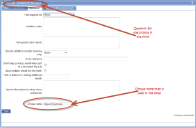|
Report processing variables are used to customise report processing, especially in relation to the text of e-mails and generation of file names. This means that entering “This is a report for ’ replaced with the actual customer name (eg Mr Smith) to generate the text "This is a report for Mr Smith" in the final report. |
CUSTOMERThe customer's current name. This is not backward compatible, so if the customer's name has changed since the form was filled in the new name will appear. |
||
LOCATIONThe customer's current location as selected on the device. This is not backward compatible, so if the location name has changed since the form was filled in the new name will appear. |
||
DATEThis is a date/time stamp in the format YYYYMMDD"T"HHMMSS |
||
SHORT_DATEThe date part of DATE: YYYYMMDD |
||
YEARThe year part of DATE: YYYY |
||
MONTHThe month part of DATE: MM |
||
WEEK_SUNDAYThe Sunday starting the week of DATE: YYYYMMDD |
||
WEEK_MONDAYThe Monday starting the week of DATE: YYYYMMDD |
||
GUIDThe unique ID given to the report. For example, FD8DFE2D-33A7-4761-A1E8-4448DE4C1541 |
||
REPORT_URLThe full web link that points to the report |
||
INSTALL_NAMEThe name for this installation of magic5 |
||
CURRENT_DATEThe current date/time in the format YYYYMMDD"T"HHMMSS |
||
CURRENT_SHORT_DATEThe date part of CURRENT_DATE: YYYYMMDD |
||
CURRENT_YEARThe year part of CURRENT_DATE: YYYY |
||
CURRENT_MONTHThe month part of CURRENT_DATE: MM |
||
CURRENT_WEEK_SUNDAYThe Sunday starting the week of CURRENT_DATE: YYYYMMDD |
||
CURRENT_WEEK_MONDAYThe Sunday starting the week of CURRENT_DATE: YYYYMMDD |
||
USERFULLNAMEThe first and last name of the user completing the form |
||
$customerThe customer name. This IS backward compatible and will display the customer name at the time the form was completed. |
||
$locationThe location. This IS backward compatible and will display the location at the time the form was completed. |
||
@xxxxThe value of an item in the current template which has the unique name of "xxxx". Unique names are automatically allocated to all items in a template, but can be overwritten during set up to make them more meaningful. This report processing variable means that any data item on the device can be used in the corresponding action. |
||
Further date formatting |
||
|
In general you can control how the dates come out in server actions as follows: Instead of using %@[unique name]%you can use %@[unique name]_Format_[dateformat]%
For example, instead of %@FromDate% you can use %@FromDate_Format_ddMMyy%
In this case, [dateformat] controls which parts of the date are shown. For example, using dd MMM yyyy,
Standard date formats include:
d: 15/6/2008
D: Sunday, June 15, 2008
f: Sunday, June 15, 2008 9:15 PM
F: Sunday, June 15, 2008 9:15:07 PM
g: 15/6/2008 9:15 PM
G: 15/6/2008 9:15:07 PM
m: June 15
o: 2008-06-15T21:15:07.0000000
R: Sun, 15 Jun 2008 21:15:07 GMT
s: 2008-06-15T21:15:07
t: 9:15 PM
T: 9:15:07 PM
u: 2008-06-15 21:15:07Z
U: Monday, June 16, 2008 4:15:07 AM
y: June, 2008
Sample dateformats include:
h:mm:ss.ff t = 9:15:07.00 P
MMM yyyy = 15 Jun 2008
HH:mm:ss.f = 21:15:07.0
dd MMM HH:mm:ss = 15 Jun 21:15:07
\Mon\t\h\: M = Month: 6
HH:mm:ss.ffffzzz = 21:15:07.0000-07:00
|




